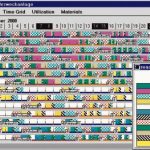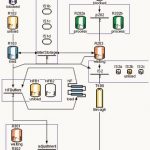Investments into enhanced capacity are made to satisfy the expected demand. At the same time, however, not a single penny must be spent on superfluous equipment. The reconciliation of these antagonistic goals can only be attained with an in-depth knowledge about the production flows. This knowledge can be acquired with material flow simulation. It enables the engineer to assess a multitude of scenarios and to pin down the most efficient one.
Dr. Philippe Solot
In today’s highly competitive ecomomy, it is of paramount importance to be able to react immediately to customer requirements. For this purpose, sufficient capacity must be available. Unfortunately, the margins in the process industry are dwindling, so that the capacity must match the expected demand as closely as possible. No company can afford wasting investments.
If a new production plant is planned, the engineer is expected to determine, on the basis of realistic scenarios of future demand, the minimum number of reactors, filters, dryers or mixers to be installed. In case of modifications to the production volume or to the product mix in an existing plant, the task is twofold. First, one has to decide whether the plant is capable of meeting the modified requirements (e.g. an increased volume of production) without any additional investment, even if the maximum seems already reached. If it can be established that there is indeed a lack of capacity, an optimal extension of the plant must be identified.
These tasks require a thorough investigation of the production logistics, taking into account the dynamics of the production flows. In particular (though not only) in multi-purpose plants, conflicts between production processes cause undesirable delays and prevent the efficient use of the existing capacity. The Gantt chart constitutes the ideal tool for the visualization of such disturbances. In practice, the engineer in charge has to set up such a diagram for each scenario and each plant configuration considered, in order to evaluate the advantages and the inconveniences of each investment variant. Since the manual construction of a single Gantt chart may take hours, rendering comparisons of several layouts an extremely tedious task, we need a tool for the quick setup of these diagrams. This tool is called material flow simulation.
Model building made easy
The material flow simulation software Sinbax has been developed on purpose to create a precise virtual image of production flows in the process industry with its peculiarities like batch production, campaigns, cleaning upon production changes, etc. Close to the real world, the model consists of three components:
- the layout as a model of the available resources,
- the recipes as models of the processes,
- the order list as a model of the orders to be processed.
The resources is not only composed of the equipment, but also of the storage places, of the various utilities as well as of the human resources including their shift model. The software provides a catalogue of approximately 50 symbols for these elements. By drag and drop into a graphics window, the layout can be created in really short time. As for the processes, a menu with more than 25 predefined steps like loading, processing, separating, cleaning,… is available for representing the different process stages and their unit operations. These steps cover the whole range from continuous operations to container handling over batch processing operations. For each step, its duration as well as, if needed, the amount transferred and the utility requirements, are specified. Logical conditions can also be specified directly in the recipe, for instance concerning tank level control in continuous processes. The process description can also be imported from Excel, which saves time during the modelling phase. Finally, the magnitude and the deadlines of the orders have to be defined as well as the production process used. For the analysis of future scenarios, Sinbax even provides a function for the automatic generation of production orders on the basis of product-specific information about the total amount and the campaign size.
Model building should always be guided by the rule “as simple as possible, as detailed as necessary“. The modular structure of the model makes it possible to validate subcomponents continuously. Hence, there is no need for a lengthy validation phase following the complete plant modelling. Consequently, the model can immediately be used to analyze demand scenarios which should be defined in advance by the plant or site management.
Intuitively appealing results
Of course, the different scenarios should be investigated consecutively. Usually, it is a good idea to start with the scenario of minimum complexity, i.e., with the smallest total amount and/or the smallest product variety. For every scenario, the software uses the model to calculate a Gantt chart in which the utilization of equipment and resources appears clearly. In addition to the pure production operations, the waiting times identified are represented by color bars and classified by causes like “equipment occupied“, “lack of utility“, “lack of personnel“, “shift model“, etc. Thanks to the animation, the user can follow the processes on the screen during the simulation. This facilitates an immediate correction of model inconsistencies and supports the explanation of the results in project meetings.
At the end of a simulation, Sinbax offers statistics and graphics about the utilization of equipment. Bottlenecks are highlighted by the software. In addition, detailed curves inform about potential problems due to the contents of tanks and storage places, the consumption of utilities, or the occupation of the work force in time. Supported by these graphical results, it is easy to derive measures to eliminate bottlenecks. Some simulation runs with incrementally improved configurations are usually sufficient to find an optimal plant configuration.
Significant savings
Sinbax has been used in many projects and in different branches of the process industry to optimize the material flows. Some of these are briefly presented below.
In a cost optimization project, the production logistics of a synthesis and formulation plant for specialty chemicals were investigated. The aim was to optimize the number and the configuration of production devices. Elimination of bottlenecks and of mutual blocking was intended to free capacity for additional production tasks, thus avoiding investment into additional equipment. In close cooperation, the production site and Aicos Technologies developed a detailed simulation model of the production processes. At first, logistically optimal processes were developed for single prod-ucts. Subsequently, the interplay of prod-ucts and the behaviour of intermediate storage places depending on their size and on the number of available containers was investigated. The result: it was possible to detect the optimal dimension of the storage places and equipment worth several million dollars can now be used for other purposes.
Several further studies dealt with multi-purpose plants for the production of active pharmaceutical ingredients. The plants were investigated with respect to the consumption of utilities. The aim was to optimize the dimension of the equipment needed to provide the utilities. Much attention was therefore devoted to the specification of the resource requirements per unit operation. It turned out to be a great advantage of logistic simulation that it allows to consider the simultaneousness of different production steps pertaining to different products and thus to estimate reliably the peak consumption of each utility. This made it possible to dimension the corresponding devices with no risk and no oversizing.
Conclusion
User-friendly software for logistic simulation make it possible to convert the tedious, costly and time-consuming task of setting up Gantt charts into a few clicks on the computer. With the use of appropriate tools, engineers in charge of plant construction or plant restructuring can concentrate on what really matters, namely the creative setup of optimal plant configuration scenarios. This is the best way to avoid wasting money for unnecessary equipment.
cpp 428
More about Simbax
Training courses in production logistics
Share:









